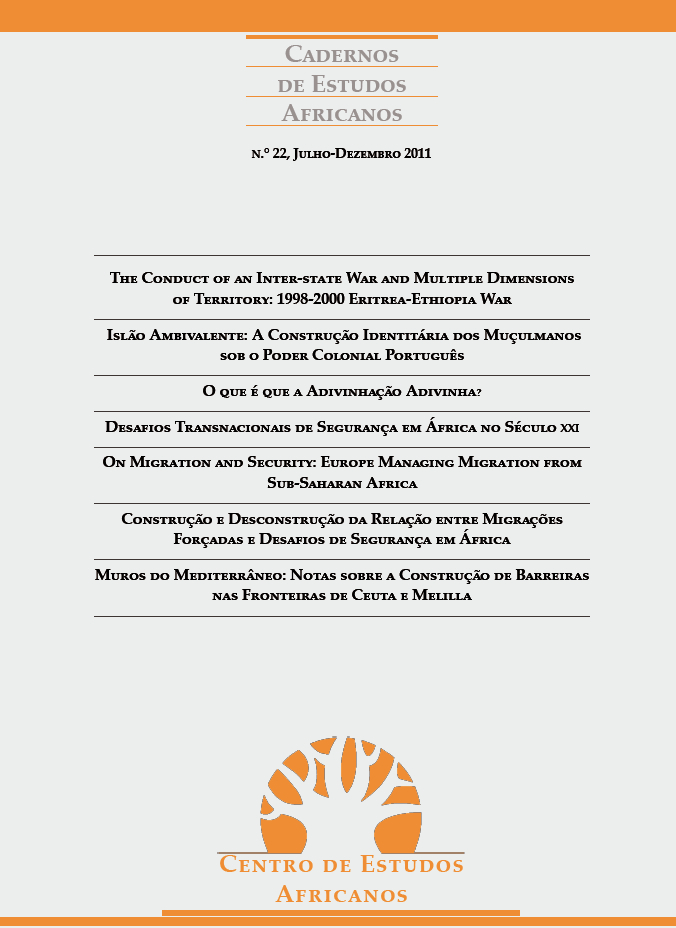Construção e Desconstrução da Relação entre Migrações Forçadas e Desafios de Segurança em África
DOI:
https://doi.org/10.4000/cea.444Palavras-chave:
segurança, migrações forçadas, cidadania, África Central, Grandes LagosResumo
A reflexão sobre desafios transnacionais de segurança enquadra-se num contexto de esbatimento do tradicional conceito de Estado, centrado num território delimitado por fronteiras e com o monopólio da violência física legítima. No contexto africano o debate assume duas dimensões importantes: vontade política e capacidade de o Estado proteger os seus cidadãos. Este artigo sugere que pelo menos a parte da vontade política está em grande medida condicionada pelo entendimento do Estado sobre a cidadania, num contexto em que a etnicidade constitui um elemento estruturante de relações e pertenças muito mais forte e de natureza transnacional. Daí que os movimentos de migrações forçadas devam ser entendidos num contexto societal, ou seja, tendo como enfoque o papel das populações e dos contextos locais de violência e paz e dinâmicas regionais no acolhimento ou rejeição dos que fogem. Em todo este processo importa perceber a forma como as migrações forçadas são construídas enquanto factor ou consequência da insegurança.Referências
Arteaga, F. (2008). The Chad conflict, United Nations (MINURCAT) and the European Union (EUFOR). ARI Paper 20.
Bellamy, A. J., & Williams, P. D. (2011). The new politics of protection? Côte d’Ivoire, Libya and the responsibility to protect. International Affairs, 87 (4), 825-850.
DOI : 10.1111/j.1468-2346.2011.01006.x
Berg, P. (2008). The dynamics of conflict in the tri-border region of the Sudan, Chad and the Central African Republic. Berlim: Friedrich Ebert Foundation, Division for International Cooperation, Department of Development Policy.
Boutros-Ghali, B. (1992). An agenda for peace: Preventive diplomacy, peacemaking and peace-keeping: Report of the Secretary-General pursuant to the statement adopted by the summit meeting of the Security Council on 31 January 1992. United Nations Department of Public Information.
Crisp, J. (2011). Forced displacement in Africa: Dimensions, difficulties, and policy directions. Refugee Survey Quarterly, 29 (3), 1-27.
DOI : 10.1093/rsq/hdq031
Freitas, R. (2002). Human security and refugee protection after September 11: A reassessment. Refuge: Canada’s Periodical on Refugees, 20 (4), 34-44.
Giroux, J., Lanz, D., et al. (2009). The tormented triangle: The regionalisation of conflict in Sudan, Chad, and the Central African Republic. Crisis States Working Papers Series 2.
Goodwin-Gill, G. S. (1999). Refugees and security. International Journal of Refugee Law, 11 (1), 1-5.
DOI : 10.1093/ijrl/11.1.1
Grawert, E. (2008). Cross-border dynamics of violent conflict. Journal of Asian and African Studies, 43 (6), 595-614.
DOI : 10.1177/0021909608096656
Ignatieff, M. (2002). Human rights, sovereignty and intervention. In N. Owen (Ed.), Human rights, human wrongs: The Oxford amnesty lectures (pp. 52-87). Oxford University Press.
Jackson, R. H. (Org.) (1990). Quasi-states: Sovereignty, international relations and the Third World. Cambridge University Press.
Lemarchand, R. (2009). The dynamics of violence in Central Africa. Philadelphia: University of Pennsylvania Press.
Loescher, G. (2003). Refugees as grounds for international action. In E. Newman, & J. Van Selm (Orgs.), Refugees and forced displacement: International security, human vulnerability, and the state (pp. 31-49). Tóquio/Nova Iorque: The United Nations University.
Mills, K., & Norton, R. J. (2002). Refugees and security in the Great Lakes Region of Africa. Civil Wars, 5 (1), 1-26.
DOI : 10.1080/13698240208402493
Milner, J. (2009). Refugees and the regional dynamics of peacebuilding. Refugee Survey Quarterly, 28 (1), 13-30.
DOI : 10.1093/rsq/hdp015
Newman, E., & Van Selm, J. (Orgs.) (2003). Refugees and forced displacement: International security, human vulnerability, and the state. Tóquio/Nova Iorque: United Nations University.
Prunier, G. (2011). Africa’s World War: Congo, the Rwandan genocide, and the making of a continental catastrophe. Oxford University Press.
Rubin, B. R., Armstrong, A., et al. (2001). Regional conflict formation in the Great Lakes Region of Africa: Structure, dynamics and challenges for policy. Nova Iorque: Center on International Cooperation.
Sany, J., & Desai, S. (2008). Transnational ethnic groups and conflict: The Zaghawa in Chad and Sudan. Conflict Trends, 1, pp. 1-25.
Teitelbaum, M. S., & Weiner, M. (Orgs.) (1995). Threatened peoples, threatened borders: World migration and U.S. policy. Nova Iorque: The American Assembly, Columbia University.
Tubiana, J. (2008). The Chad-Sudan proxy war and the ”darfurization” of Chad: Myths and reality. Working Paper nº 12. Genebra: Small Arms Survey, Graduate Institute of International Studies.
UN General Assembly (2005). 2005 World summit outcome. A/60/L.1.
UNDP (1993). Human development report 1993: People’s participation. United Nations.
Weiner, M. (1992). Security, stability and international migration. International Security, 17, pp. 91-126.
DOI : 10.2307/2539131
Weiss, T. G. (2011). The UN has proved its worth in Libya and Ivory Coast. The Independent. Acedido em 6 Julho, 2011, de http://www.independent.co.uk/opinion/commentators/thomas-g-weiss-the-un-has-proved-its-worth-in-libya-and-ivory-coast-2263655.html?service=Print
Wheeler, N. J. (1992). Pluralist or solidarist conceptions of international society: Bull and Vincent on humanitarian intervention. Millennium Journal of International Studies, 21 (2), 463-487.
DOI : 10.1177/03058298920210030201
Wheeler, N. J. (Org.) (2000). Saving strangers: Humanitarian intervention in international society. Oxford University Press.
Downloads
Publicado
Edição
Secção
Licença
Direitos de Autor (c) 2016 Cadernos de Estudos Africanos

Este trabalho encontra-se publicado com a Licença Internacional Creative Commons Atribuição-NãoComercial-CompartilhaIgual 4.0.
Autorizo a publicação do artigo/recensão submetido do qual sou autor.
Declaro ainda que o presente artigo é original, que não foi objecto de qualquer tipo de publicação, e cedo em exclusivo os direitos de publicação à revista Cadernos de Estudos Africanos. A reprodução do artigo, no todo ou em parte, noutras publicações ou noutros suportes depende de autorização prévia da editora Centro de Estudos Internacionais do Iscte - Instituto Universitário de Lisboa.

